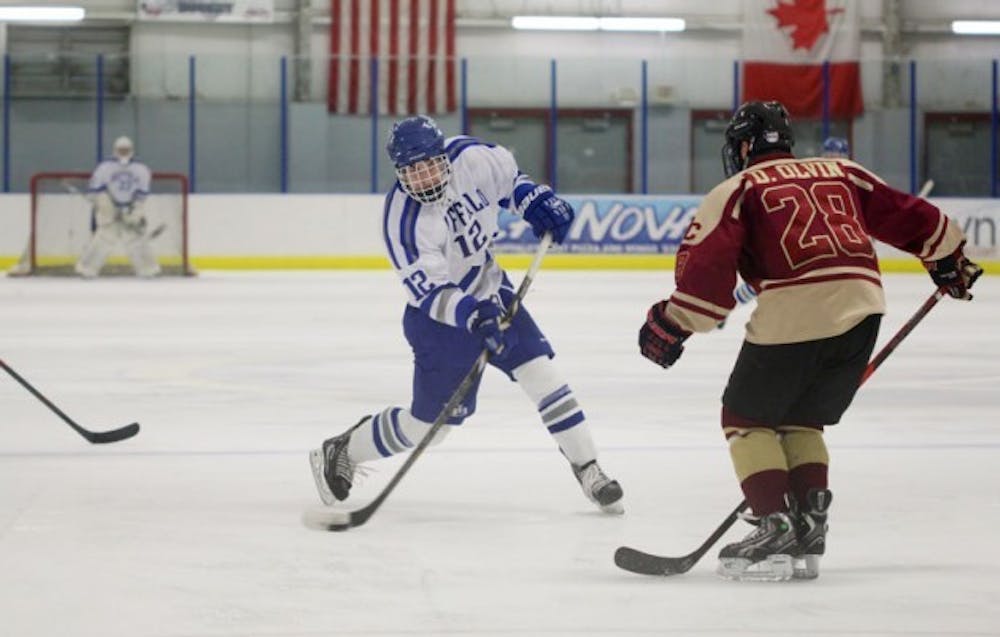When one hears the phrase, ‘club hockey,’ the competiveness is often associated with that of a “beer league” – a league not taken seriously – according to Buffalo men’s ice hockey head coach Sal Valvo.
But not at the University at Buffalo.
The Bulls compete in the Northeast Collegiate Hockey League of the American Colligate Hockey Association (ACHA), otherwise known as club hockey. Unlike other programs at UB like the football and basketball teams, the men’s ice hockey team receives limited funding and its players do not receive scholarships.
Despite their status as a club team and the struggles that come along with it, the Bulls have been one of the most successful teams on campus over the past several years. They won the ACHA title in 2013 and made it to the semifinal last season.
The main difference between the ACHA and the NCAA is funding.
The Student Association provides a portion of the Bulls’ budget – $14,000 – but this does not even cover ice time, which alone costs $30,000.
Factor in 35 regular season games, practices, travel and hotel fees; the total amount for the Bulls’ Division I program comes to around $60,000. The newly added Buffalo Division III team had a budget of $30,000.
One of the biggest challenges the team faces is managing this money.
Unlike NCAA teams, who have a hired staff for this responsibility, it’s up to players, coaches and other staff members to handle the team’s finances.
“We have advisers, [volunteers] that help us off the ice,” Valvo said. “Guys that manage everything from hotels to ice time, assistant coaches who schedule the game schedule the following year, guys that help us with finances. We need lots of hands on deck to help us. Everybody on staff is a volunteer; no coaches have stipends. Everyone loves to do it.”
Like the NCAA, the ACHA has three divisions – I, II, and III – with I being the most competitive. But ACHA programs don’t cover league fees or players’ tuitions like the NCAA.
Because of this, ACHA programs raise as much money as possible.
“We’ve sold military T-Shirts, had military appreciation nights, even [sold] candy bars; any way to fundraise,” Valvo said. “Every dime we get we put it right back into program.”
Despite being a non-scholarship program, Valvo said his players are “as dedicated as any other NCAA player at [UB].”
The team practices at 5:30 a.m., three days a week with games scheduled for Friday, Saturday and sometimes Sunday. Because the Bulls are not playing in the NCAA, working around class and tests in order to play and practice can be difficult.
“If [one of our players] has a quiz or test on the weekend, we do ask if we can monitor them or take [it] before we leave,” Valvo said. “If the teacher agrees, fine. But if not, there’s nothing we can do. Our students are here to get a degree. I know that and they know that.”
Why then, would Valvo and his ensemble of staff members and student-athletes agree to partake in something that involves so many struggles?
“For the love of the game,” said senior defenseman Mike Pliszka. “Throughout your whole life it’s really nothing out of the ordinary [paying for hockey]. No one expects [to play for free]. It costs money but you get the chance to keep playing competitive hockey, which a lot of people our age don’t have the opportunity to do.”
Despite the perceptions of club sports and club hockey, the ACHA Division I is competitive.
In 2012, ACHA Division I Arizona State University played first-year NCAA Division I Penn State. ASU split the series, losing 8-3 and then winning 3-1.
According to Pliszka, there’s no greater feeling than contributing to your team’s success, no matter what level you compete in.
“No matter how old you are or what competition you play, scoring a big goal or throwing a big hit makes you feel like a little kid again,” Pliszka said. “You just can’t beat that feeling. Going to the rink – it’s [hockey players’] sanctuary – [you] get away from your problems at home. Scoring that goal for not only yourself but for your team, you can talk to anyone that’s ever played, there’s no better feeling than that.”
The Bulls, unlike most club sports, have the luxury of having a rink nearby.
The Bulls play at the Northtown Center in Amherst which is a three-minute walk over Millersport Highway and across the street from North Campus. The awareness of the ice hockey program has been increasing over the past several years, according to Valvo. The Bulls sometimes attract large crowds to their home games.
“We’ve had some phenomenal nights where we’ve had maybe 600 fans here,” Valvo said. “There was a section of fans standing beating on the glass. They brought noisemakers – the ref asked me to get them to be quiet. I said, ‘How can I do that? They’re fans.’ I think some teams are jealous that we have such a good fan base … it’s neat to see adults in the community just to see the team, that aren’t students or have kids [attending UB]. Those are the people we’re trying to reach out to.”
The Bulls played in the NCAA until 1988, and although the ultimate goal would be to get back to there, for now the team is content with its club status.
"Our overall goal every day is to get better,” Valvo said. “What this takes us to I don’t know. If the university decides to go NCAA – right now we like being a non-scholarship team. We like being the hockey team at UB.”
email: sports@ubspectrum.com





